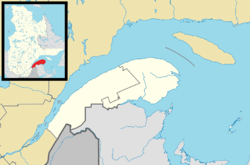Sayabec | |
|---|---|
 | |
 Location within La Matapédia RCM. | |
| Coordinates: 48°34′N 67°41′W / 48.567°N 67.683°W[1] | |
| Country | |
| Province | |
| Region | Bas-Saint-Laurent |
| RCM | La Matapédia |
| Settled | mid 19th century |
| Constituted | December 24, 1982 |
| Government | |
| • Mayor | Marcel Belzile |
| • Federal riding | Haute-Gaspésie—La Mitis—Matane—Matapédia |
| • Prov. riding | Matane-Matapédia |
| Area | |
• Total | 138.50 km2 (53.48 sq mi) |
| • Land | 130.31 km2 (50.31 sq mi) |
| Population | |
• Total | 1,706 |
| • Density | 13.1/km2 (34/sq mi) |
| • Pop 2016-2021 | |
| • Dwellings | 872 |
| Time zone | UTC−5 (EST) |
| • Summer (DST) | UTC−4 (EDT) |
| Postal code(s) | |
| Area code(s) | 418 and 581 |
| Highways | |
| Website | www.municipalite sayabec.com |
Sayabec (/seɪbɛk/) is a municipality located in the La Matapédia Regional County Municipality (RCM) in Bas-Saint-Laurent, Quebec, Canada. It is located in the Matapédia Valley between the Chic-Choc Mountains of the Appalachian near Lake Matapédia. The main activities of the village are agriculture and forestry. It has a population of approximately 2,000, the third biggest municipality in its RCM after Amqui and Causapscal. Due to the presence of the chipboards plant called Panval, the biggest industry of the valley, Sayabec is an important regional economic centre.
The territory was historically occupied by Mi'kmaq people, a First Nation who occupied much of the Gaspé Peninsula. Its first French Canadian inhabitant was Pierre Brochu, who came in 1833. At the end of the 19th century settlers began to come in the region to work in sawmills. The municipality was first officially created in 1887 as a school municipality under the name Sainte-Marie-de-Sayabec. The Catholic parish was erected in 1894. In 1917, the village of Saindon was created, and it took the name of Sayabec in 1951. Today municipality was formed in 1982 through the merger of the parish municipality of Sainte-Marie-de-Sayabec and the village municipality of Sayabec.
The municipality's main transportation link is the Quebec Route 132 which loops around the Gaspé Peninsula back towards the Mont-Joli area northwest of Sayabec. It is also located along the Canadian National Railway (originally the Intercolonial Railway).
Sayabec is pronounced "Say-bec" (/se.bɛk/). This name comes from the Mi'kmaq language word sepeg, which means "full river" or "river obstructed by a beaver dam". In fact, the actual Mi'kmaq word is sakpediak, sak meaning "river" and pediak "full", but the Mi'kmaq used to say "sakbak" to be shorter. Other sources say that the name is from the Mi'kmaq word siapeg, which means "extension of the lake" or "small gulf".
Demonyms of Sayabec are "Sayabécois" for male gender and "Sayabécoise" for female.[4]
- ^ Cite error: The named reference
toponymiewas invoked but never defined (see the help page). - ^ a b "Sayabec". Répertoire des municipalités (in French). Ministère des Affaires municipales, des Régions et de l'Occupation du territoire. Archived from the original on 2015-06-17. Retrieved 2012-01-26.
- ^ a b Cite error: The named reference
cp2021was invoked but never defined (see the help page). - ^ "Sayabec". Commission de toponymie du Québec. Retrieved 30 November 2016..

